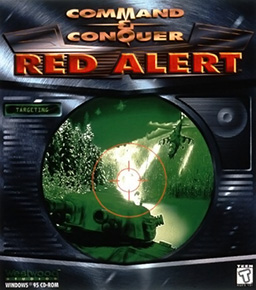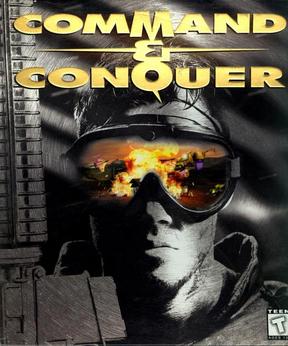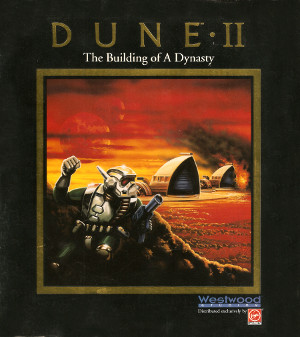Real-time strategy (RTS) is a subgenre of strategy video games that doesn't progress incrementally in turns, but allow all players to play simultaneously, in "real time". By contrast, in turn-based strategy (TBS) games, players take turns to play. The term "real-time strategy" was coined by Brett Sperry to market Dune II in the early 1990s.
Command & Conquer (C&C) is a real-time strategy (RTS) video game franchise, first developed by Westwood Studios. The first game was one of the earliest of the RTS genre, itself based on Westwood Studios' influential strategy game Dune II and introducing trademarks followed in the rest of the series. This includes full-motion video cutscenes with an ensemble cast to progress the story, as opposed to digitally in-game rendered cutscenes. Westwood Studios was taken over by Electronic Arts in 1998 and closed down in 2003. The studio and some of its members were absorbed into EA Los Angeles, which continued development on the series.

Frank Klepacki is an American musician and video game composer, best known for his work on the Command & Conquer series. Having learned to play drums as a child, he joined Westwood Studios as a composer when he was 17 years old. He has scored several games there, including the Lands of Lore series, Westwood Studios' Dune games, The Legend of Kyrandia series, Blade Runner, and the Command & Conquer series. His work in Command & Conquer: Red Alert won two awards.

Pandemic Studios, LLC was an American video game developer based in Westwood, Los Angeles. Andrew Goldman and Josh Resnick founded the studio in 1998 after leaving Activision. Pandemic Studios, alongside BioWare, was acquired in 2005 by Elevation Partners and placed under VG Holding Corp., which in 2007 was sold to Electronic Arts (EA). EA closed Pandemic Studios in 2009. Pandemic Studios is known for a variety of titles, including Full Spectrum Warrior, Star Wars: Battlefront, Dark Reign 2, Destroy All Humans!, Mercenaries, and The Saboteur.

Louis Castle is an American video games designer. He is known for co-founding Westwood Studios, designing the PC game Blade Runner, and collaborating with Steven Spielberg on the Boom Blox and Boom Blox Bash Party video games for the Wii console based on Spielberg's design ideas.
Criterion Games is a British video game developer based in Guildford. Founded in January 1996 as a division of Criterion Software, it was owned by Canon Inc. until Criterion Software was sold to Electronic Arts in October 2004. Many of Criterion Games' titles were built on the RenderWare engine, which Criterion Software developed. Notable games developed by Criterion Games include racing video games in the Burnout and Need for Speed series. As of April 2017, Criterion Games employ approximately 90 people.

Command & Conquer: Red Alert is a real-time strategy video game in the Command & Conquer franchise, developed and published by Westwood Studios in 1996. The second game to bear the Command & Conquer title, Red Alert is the prequel to the original Command & Conquer of 1995, and takes place in the alternate early history of Command & Conquer when Allied Forces battle an aggressive Soviet Union for control over the European mainland.

Command & Conquer is a real-time strategy video game developed and published by Westwood Studios in 1995. Set in an alternate history, the game tells the story of a world war between two globalized factions: the Global Defense Initiative of the United Nations and a cult-like militant organization called the Brotherhood of Nod, led by the mysterious Kane. The groups compete for control of Tiberium, a mysterious substance that slowly spreads across the world.

Command & Conquer: Tiberian Sun is a 1999 real-time strategy video game developed by Westwood Studios, published by Electronic Arts, and released exclusively for Microsoft Windows in August 1999. The game is the sequel to the 1995 game Command & Conquer. It featured new semi-3D graphics, a more futuristic sci-fi setting, and new gameplay features such as vehicles capable of hovering or burrowing. The main story of the game focuses on a second war between the UN-backed Global Defense Initiative (GDI) and the cult-like Brotherhood of Nod, both seeking to rule over an Earth which is undergoing rapid ecological collapse.

Dune II: The Building of a Dynasty is a real-time strategy Dune video game developed by Westwood Studios and released by Virgin Games in December 1992. It is based upon David Lynch's 1984 film Dune, an adaptation of Frank Herbert's science fiction novel of the same name.

Command & Conquer: Renegade is a first- and third-person shooter video game developed by Westwood Studios and is part of the Command & Conquer series. It is the only Command & Conquer game that uses the first-person view. It was released on February 26, 2002 by EA Games. The game received generally favorable reviews from critics.
Brett Sperry is an American video game designer, a fine arts gallerist, and a professional photographer. He is also a leading developer of the Las Vegas arts community where he's made significant investments in property and infrastructure, primarily in the Downtown Las Vegas area.

Joseph David Kucan is an American video game developer, director, actor, screenwriter, and casting director for various gaming companies and films. He is a resident of Las Vegas, Nevada. He is well known for his role as Kane from the Command & Conquer series.

Command & Conquer 3: Tiberium Wars is a 2007 science fiction real-time strategy video game developed and published by Electronic Arts for Windows, Mac OS X and Xbox 360 platforms, and released internationally in March 2007. The game is a direct sequel to the 1999 game Command & Conquer: Tiberian Sun, and takes place roughly seventeen years after the game's expansion pack Firestorm, in which Tiberium has grown to become a considerable threat to the planet, leading to the world's political borders and territories being remade into zones denoting the level of contamination by the alien substance. The game's story sees the Global Defense Initiative and the Brotherhood of Nod engage in a new global conflict, this time as major superpowers, only for the war to attract the attention of a new extraterrestrial faction known as the Scrin, which attacks both sides while harvesting Tiberium for its own purpose.
EA Pacific was a developer formally owned by Virgin Interactive's North American operations, and was based in Irvine, California. Burst Studios was beset by production problems during its early years; Virgin Interactive's president of worldwide publishing, Brett W. Sperry, commented in 1997, "The way the Burst studio was structured made a lot of sense on paper, but for a variety of reasons, it wasn't delivering product at the end of the day." Burst Studios was acquired by Electronic Arts together with Westwood Studios and Virgin's North American publishing operations in August 1998. The company was later renamed to Westwood Pacific, under that name, the company developed or co-developed games like Nox and Command & Conquer: Red Alert 2.
Edward Del Castillo is the Founder, Executive President, and Chief Creative Officer of Liquid Entertainment.
Renegade X is a tactical first and third-person shooter video game with real time strategy elements created by Waqas Iqbal (Havoc89). It is a free, fan-made remake of Command & Conquer: Renegade, which itself was a spin-off of the strategy series Command & Conquer published by Westwood Studios and later by Electronic Arts (EA). The developers entered open beta on February 26, 2014, and in 2023 the game is mostly dead with the original development team gone.
Mark Skaggs is an American video game producer and executive. Skaggs is known for leading the team that created the Facebook game FarmVille for Zynga, leading the team that created CityVille. He served as Executive Producer and product lead for the PC real-time strategy games Command & Conquer: Red Alert 2, Command & Conquer: Generals, and The Lord of the Rings: The Battle for Middle-earth.











